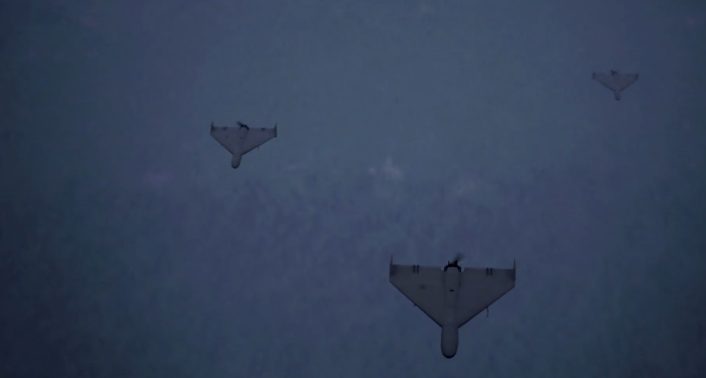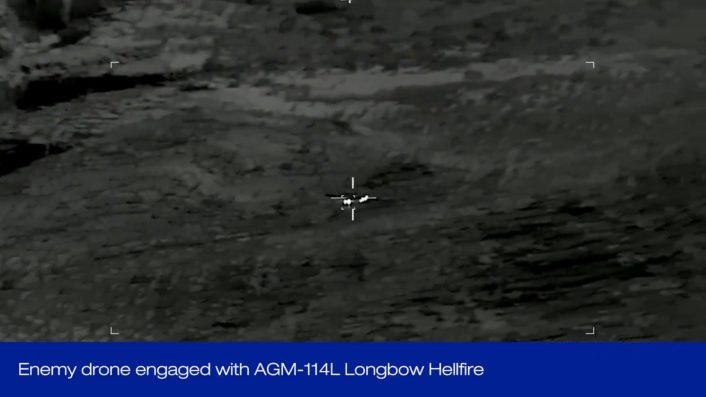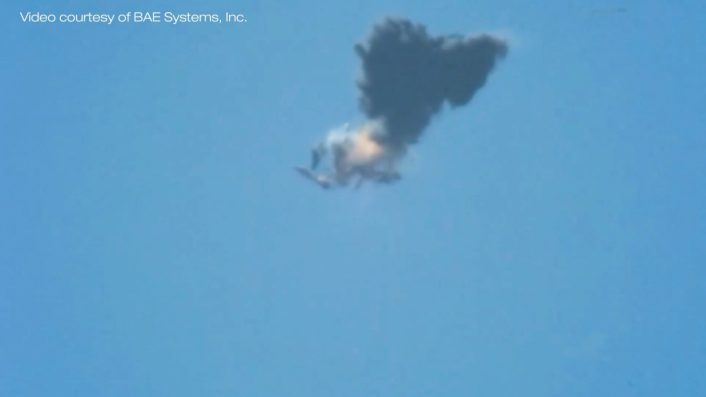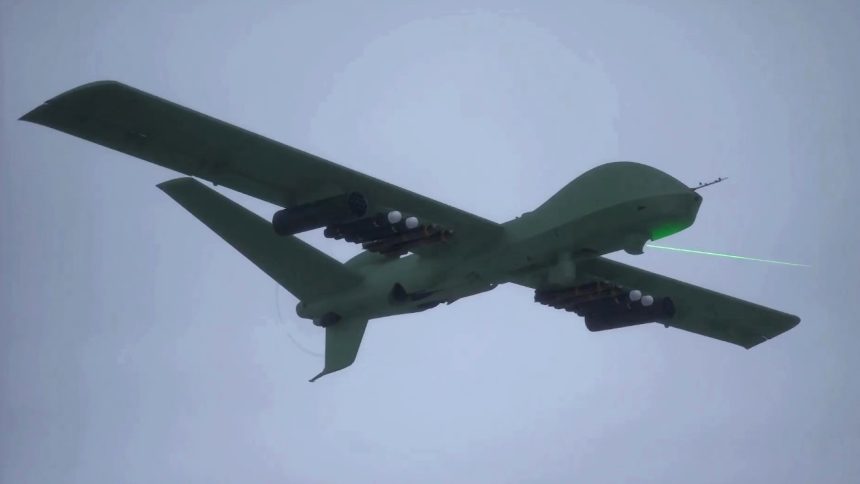While Gray Eagle STOL demonstrated anti-drone capability with AGM-114 Hellfire and APKWS II, the STOL kit for the MQ-9B would enable organic anti-submarine warfare and fleet defense.
General Atomics-Aeronautical Systems, Inc. (GA-ASI) released a video on May 14, 2025, showing both computerized illustrations and actual test footage of its Gray Eagle Short Take-Off Landing (STOL) Unmanned Aerial System (UAS) engaging target drones with AGM-114 Hellfire missiles and the Advanced Precision-Kill Weapons System II (APKWS II).
The modified 70 mm Hydra rockets have been used by F-16s deployed to the Central Command (CENTCOM) Area of Responsibility (AOR) in the air-to-air role against Houthi drones and missiles, instead of the costlier AIM-9 Sidewinders and AIM-120 AMRAAMs. Hellfires have been employed from the U.S. Navy’s Littoral Combat Ships as a novel Counter-UAS (C-UAS) capability.
While it cannot be clearly made out in the video, it appears that the Gray Eagle STOL is carrying eight Hellfires on four twin-rail launchers, as well as two pods for APKWS rockets. It also appears two different Hellfire variants are used, with four AGM-114R and four AGM-114L Longbow Hellfires.
The illustrative video shows the Gray Eagle STOL detecting the hostile drones, which interestingly resemble Russia’s Geran-2 kamikaze drones derived from the Iranian Shahed-136, launched from a truck-mounted box carrier. The Gray Eagle STOL then proceeds to track and engage them.
With counter-UAS operational capability, Gray Eagle® STOL multi-mission expeditionary #UAS can detect, intercept and neutralize adversary drone threats – delivering armed reconnaissance, surveillance and target acquisition mission support to ground troops in contested… pic.twitter.com/iuLCiuaIIc
— General Atomics Aeronautical Systems, Inc (GA-ASI) (@GenAtomics_ASI) May 14, 2025
Hellfire and APKWS as C-UAS weapons
The engagement scenes show actual test footage with the target drones, a quadcopter-like UAV and a V-tail configured UAV, engaged by a Hellfire and a APKWS rocket respectively. The shoot down of the former appears to be captured from the Electro-Optical (EO) turret of the Gray Eagle STOL itself, showing the missile flying towards the target before impact.

The UAS might also receive the new Infra-Red (IR) seeker version of the APKWS II, further easing the drone’s (or its ground controller’s) need to keep the target illuminated, like it is meant for the F-16s while tackling large swarms. Gray Eagle STOLs can operate as a type of Combat Air Patrol (CAP) from carriers against such low-end mass threats, unburdening the gunnery and air defense crews on both the carriers and escorting Arleigh Burke-class Aegis destroyers.

Both the AGM-114R and AGM-114L Hellfires are still within the pricier spectrum of the low-cost solutions to engage $15,000-$20,000-worth Houthi weapons, costing well over $215,000. They are differentiated by a laser and a Millimeter Wave Radar (MMR) seeker, respectively.
It is not clear when or where this tests took place, but interestingly they come within nearly a month of The War Zone quoting GA-ASI officials who revealed the U.S. Army’s MQ-1C Gray Eagle used the AGM-114L Longbow Hellfire missile to shoot down a drone in live-fire tests.

STOL kit for MQ-9B
Interestingly, a day prior to the revealing of the C-UAS test, on May 13, 2025, GA-ASI revealed on LinkedIn the wind tunnel testing of a scale model of a “Short Take-Off Landing (STOL) mission kit” for its MQ-9B SeaGuardian and SkyGuardian drones.
Conducted at the National Institute for Aviation Research, the scale model testing assessed the “aerodynamic performance, stability and control of current designs.” The post further said that, “With the MQ-9B STOL mission kit, MQ-9B SkyGuardian and SeaGuardian RPAS will soon operate from aircraft carriers.”
The LinkedIn post showed a single front-view image of the SeaGuardian/SkyGuardian model inside the wind tunnel.
Related programs?
The wings of the STOL kit appear to share their large width with the purpose-built Gray Eagle STOL. The wings on the scale model also show a number of underwing hardpoints, similar to the Gray Eagle STOL. The similarities might not be casual as the Gray Eagle STOL has already been tested flying from ships at sea.
The STOL kit could be a rapidly configurable system that can be retrofitted onto the existing MQ-9Bs, lending them the Gray Eagle STOL’s lift and wing-loading to take off from carriers and execute C-UAS missions with Hellfires and APKWS rockets. So far, GA-ASI’s website does not mention a C-UAS role for the MQ-9B STOL, but this might change in future.
Although the Gray Eagle is the UAS shown in the video carrying APKWS and Hellfires and engaging the target drones, the capability could easily be extended to the MQ-9B with the STOL kit, given how it would share the wing design and structure. The test may very well have been a way to quickly prove the Gray Eagle STOL wing’s compatibility with the Hellfire and APKWS, before its kitted form is tested on the MQ-9.
General Atomics, alongside Hanwha Aerospace, made aviation history when #GrayEagleSTOL took off from a South Korean naval warship meant for helicopters and landed at a ground base.
The ability to operate from various warships unlocks new multi-domain operations for UAS. pic.twitter.com/OXVDLy1D7v
— General Atomics Aeronautical Systems, Inc (GA-ASI) (@GenAtomics_ASI) November 13, 2024
As already reported in previous articles, Gray Eagle STOL is the name of the production variant of the Mojave demonstrator aircraft, and shares commonality with the baseline Gray Eagle aircraft. The Gray Eagle STOL has also been tested to operate from allied aircraft carriers like the Royal Navy’s HMS Prince of Wales in 2023 and the Republic of Korea Navy’s (RoKN) amphibious landing ship Dokdo on Nov. 12, 2024.
GA-ASI first revealed the “STOL mission kit” in a Feb. 2023 concept video, saying “the wing and tail kit [are] inspired by the smaller Mojave.” The video explained that the larger and higher performance MQ-9B would become the “MQ-9B STOL” and be able to “operate from more expeditionary bases or big-deck amphibious vessels.”
The MQ-9B STOL will be able to stay where needed longer, says the company, while being “ready for tasking, whether deployed over ground or naval forces.” This “short-field advantage,” allows the MQ-9B STOL to switch between “organic anti-submarine warfare and fleet defense,” without having to return to land-bases for refueling and maintenance.
The MQ-9B STOL is also shown equipped with folding wings, in addition to hardened landing gears for operating off the U.S. Navy flat-tops. Beside the Sonobuoy Dispensing System (SDS) pods and the Raytheon SeaVue multimode radar, the SeaGuardian in the MQ-9B STOL concept video is also shown carrying AIM-9 Sidewinder short-range AAMs.
Marines, Reapers and MQ-9 distributed operations
Interestingly, the MQ-9B SeaGuardian in that video bears the marking of VMU-1 (Marine Unmanned Aerial Vehicle Squadron-1). VMU-1, part of 3rd Marine Aircraft Wing (3 MAW) at Yuma, Arizona, received the U.S. Marine Corps’ first MQ-9A Reaper in Aug. 2021. GA-ASI also identifies the “Pacific Theater” benefiting from the Gray Eagle STOL’s “critical new” and “unprecedented runway independence” capability, being able to “launch from warships to dirt fields.”
Thus, the U.S. Marine Corps might possibly be a leading beneficiary of the MQ-9 Predator STOL kit. The service is actively equipping its MQ-9 Block 5 drones with podded systems like the SkyTower II (STII) advanced Communications Intelligence (COMINT) relays. As of 2024, the USMC has received ten Reapers. Another ten are scheduled for delivery in 2025.
VMU-3 Taxis the MQ-9A#PacificMarines with Marine Unmanned Aerial Vehicle Squadron (VMU) 3, Marine Aircraft Group 24, @1stMAW_Marines, taxi the flight line with an MQ-9A on Marine Corps Air Station Kaneohe Bay, June 20. pic.twitter.com/fJm0YQHJWt
— Pacific Marines (@PacificMarines) June 27, 2023
The MQ-9 Predator is still seen holding value in modern battle spaces, being involved in Agile Combat Employment (ACE) exercises, despite not being oriented design-wise for this kind of operations like its STOL derivative, the Mojave. Prior to that, the unmanned aircraft was tested logistically to operate from non-paved, austere runways during Exercise Reaper Castillo, held from Nov. 4 to Dec. 18, 2024.









